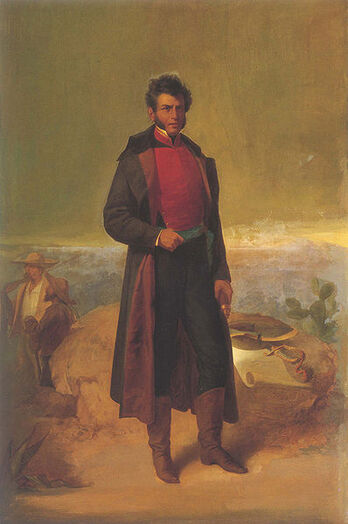¡Viva México![]

Agustín Cosme Damián de Iturbide y Arámburu, "The Mexican Napoleon"
In late 1827, the Mexicans finally overthrew the skeleton crew Spanish army holding the colony down. Ferdinand had been dead for several months, and news had reached New Spain long ago that the young King of Rome was preparing to seize the Spanish Throne. This was the opportune moment for a new independent government to rule in Mexico and join the North American circle of nations. Radicals were moving in from Gran Colombia, and they had already established the "Mexican Republic of Panama" with the expressed purpose of having it be the cornerstone for a new Mexican nation. Georgian and French troops were moving in from New Orleans and establishing camps in Texas. The militarists in Georgia still held high the name of Archibald Bulloch, their first Prime Minister, and the fear was growing that they seemed to be pondering an all-out French-backed invasion to add more territory to their own little "empire." The Mexicans urged Texas to resist peacefully, and it left the Georgians in no position to "give aide" or "militarily assist" the "very independent" Mexico. In other words, Georgia couldn't pull the same trick Virginia had in Cuba. Instead, once the newly forming Mexico City government told the easterners to get out, they had no choice but to do so or look like total aggressors. The leader of the Mexican revolutionaries was Agustín Cosme Damián de Iturbide y Arámburu, better known simply as Iturbide, and he possessed the mind of a genius. He rallied the ad-hoc army he had assembled, acquired uniforms for the elites, and marched them north to the Louisiana border and held a formal ceremony at the departure of the French and Georgian "allies," to send a message they were not welcome to return. Iturbide then proceeded to systematically purge his government of all who opposed him, which he cheerfully called "starting out on the right foot." The next move after that was to formally absorb Panama into the "Confederated Empire of Mexico." In mid-1828, he sent troops to fight with the Gran Colombians in South America, in an attempt to finally rid the two continents of Spanish rule forever. It would become a bloody affair, lasting till 1831. The Spanish in South America were being reinforced by the fleeing Spanish loyalists in Europe who desperately wanted to continue Bourbon rule in exile, and they made the going much tougher for the liberators. France at first helped in Peru against their common Spanish enemy, striking out from Brazil, but soon after ceased doing so, becoming increasingly wary of Iturbide's intentions. In late 1828, Iturbide finally made it known that he was now the Emperor, absolute in power, of all Mexico. He proclaimed that his empire stretched from Texas in the east, to Panama in the south, to southern California to the west. France was horrified, and immediately officially annexed more western territory onto Louisiana, hoping to eventually head off the Mexican Napoleon on the route to the Pacific. The land-race would continue until 1840.

Flag of the Confederated Empire of Mexico
Iturbide faced a civil war in Texas in 1830, led by a local militia leader known simply by the commoners as "Santa Anna." Several violent confrontations occurred, with many Santa Anna supporters being killed by government troops. Iturbide "crossed the aisle" in a gesture of "good will and patriotic camaraderie" and offered to give Texas more local authority and jurisdiction, as well as officially renaming the country as "the Confederated Empire of Mexico and Texas." Texas refused, and in a bloody last stand at an abandoned Catholic mission, Santa Anna's largest force was brutally overwhelmed and massacred by Iturbide's forces. The rebel leader barely escaped with his life.

The Alamo Mission, site of the brutal siege that destroyed Santa Anna's largest army
Georgia finally intervened and sent troops into Texas once again, followed by a declaration of war on the Mexican Empire. The modern Georgian army and navy soon humiliated Iturbide, and he grudgingly was forced to accept a peace treaty that guaranteed Texan independence. The frustrated Mexican Napoleon slunk back to Mexico City to sulk, and continue his plans for northwest expansion.

Flag of the Democratic Republic of Texas
Santa Anna busied himself forming a slave and agriculture based economy, modeled on Georgia's, and made sure to keep his few soldiers on the Mexican border on guard at all times. In 1832, Texas officially adopted a democratic-republican system of government and fairly elected Antonio Lopez de Santa Anna as its first Prime Minister.
Down in war-torn South America, Peru had declared independence in its capital of Lima. Though a general named Antonio Jose Estevez had tried to initially declare himself prince (as well as an ally of Iturbide), the people rejected and exiled him and drew up a republican system of government, based largely on Virginia. It welcomed Virginian legal advisers to come in and help write the new constitution. The young republic then looked inward and forward to a hopefully peaceful future.

Flag of the Republic of Peru
Chile declared itself independent in 1831, a year after Peru, and based itself on similar ideas and beliefs. However, once a series of Mexican-backed dictators were overthrown in a series of brutal revolts, the smoldering ash-heap of a country lost its independence to Peru, who finally brought in rule of law and stable leadership. The last Mexican troops withdrew as the most recent government was imprisoned, thus ending Iturbide's "Wars of Liberation." Down in Argentina, the French had taken over in 1828-1829, and all attempts at independence were quashed utterly, ending in the execution by guillotine of rebel leader José de San Martín. The French then made Argentina a colonial administration, and turned it into just another part of the monstrously bloated French Empire.